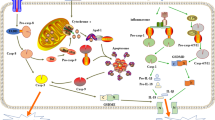Abstract
Serine protease dependent cell apoptosis (SPDCA) is a recently described caspase independent innate apoptotic pathway. It differs from the traditional caspase dependent apoptotic pathway in that serine proteases, not caspases, are critical to the apoptotic process. The mechanism of SPDCA is still unclear and further investigation is needed to determine any role it may play in maintaining cellular homeostasis and development of disease. The current knowledge about this pathway is limited only to the inhibitory effects of some serine protease inhibitors. Synthetic agents such as pefabloc, AEBSF and TPCK can inhibit this apoptotic process in cultured cells. There is little known, however, about biologically active agents available in the cell which can inhibit SPDCA. Here, we show that over-expression of a cellular protein called serine protease inhibitor Kazal (SPIK/TATI/PSTI) results in a significant decrease in cell susceptibility to SPDCA, suggesting that SPIK is an apoptosis inhibitor suppressing this pathway of apoptosis. Previous work has associated SPIK and cancer development, indicating that this finding will help to open the doorway for further study on the mechanism of SPDCA and the role it may play in cancer development.







Similar content being viewed by others
Abbreviations
- BFA:
-
Brefeldin A
- CDCA:
-
Caspase dependent cell apoptosis
- CHX:
-
cycloheximide
- SPDCA:
-
Serine protease dependent cell apoptosis
- SPIK:
-
Serine protease inhibitor Kazal
References
Igney FH, Krammer PH (2002) Death and anti-death: tumour resistance to apoptosis. Nat Rev Cancer 2:277–288
Nicholson DW, Thornberry NA (1997) Caspases: killer proteases. Trends Biochem Sci 22:299–306
Nunez G, Benedict MA, Hu Y, Inohara N (1998) Caspases: the proteases of the apoptotic pathway. Oncogene 17:3237–3245
Deveraux QL, Reed JC (1999) IAP family proteins–suppressors of apoptosis. Genes Dev 13:239–252
Deveraux QL, Roy N, Stennicke HR, Van Arsdale T, Zhou Q, Srinivasula SM et al (1998) IAPs block apoptotic events induced by caspase-8 and cytochrome c by direct inhibition of distinct caspases. Embo J 17:2215–2223
Egger L, Schneider J, Rheme C, Tapernoux M, Hacki J, Borner C (2003) Serine proteases mediate apoptosis-like cell death and phagocytosis under caspase-inhibiting conditions. Cell Death Differ 10:1188–1203
Thorburn J, Bender LM, Morgan MJ, Thorburn A (2003) Caspase- and serine protease-dependent apoptosis by the death domain of FADD in normal epithelial cells. Mol Biol Cell 14:67–77
Abate A, Schroder H (1998) Protease inhibitors protect macrophages from lipopolysaccharide-induced cytotoxicity: possible role for NF-[kappa]B. Life Sci 62:1081–1088
Graf R, Bimmler D (2006) Biochemistry and biology of SPINK-PSTI and monitor peptide. Endocr Metab Clin North Am 35:333–43, ix
Stenman UH (2002) Tumor-associated trypsin inhibitor. Clin Chem 48:1206–1209
Paju A, Stenman UH (2006) Biochemistry and clinical role of trypsinogens and pancreatic secretory trypsin inhibitor. Crit Rev Clin Lab Sci 43:103–142
Greene LJ, Pubols MH, Bartelt DC (1976) Human pancreatic secretory trypsin inhibitor. Methods Enzymol 45:813–25
Ohmachi Y, Murata A, Matsuura N, Yasuda T, Uda K, Mori T (1994) Overexpression of pancreatic secretory trypsin inhibitor in pancreatic cancer. Evaluation of its biological function as a growth factor. Int J Pancreatol 15:65–73
Tomita N, Doi S, Higashiyama M, Morimoto H, Murotani M, Kawasaki Y et al (1990) Expression of pancreatic secretory trypsin inhibitor gene in human colorectal tumor. Cancer 66:2144–2149
Lukkonen A, Lintula S, von Boguslawski K, Carpen O, Ljungberg B, Landberg G et al (1999) Tumor-associated trypsin inhibitor in normal and malignant renal tissue and in serum of renal-cell carcinoma patients. Int J Cancer 83:486–490
Tonouchi A, Ohtsuka M, Ito H, Kimura F, Shimizu H, Kato M et al (2006) Relationship between pancreatic secretory trypsin inhibitor and early recurrence of intrahepatic cholangiocarcinoma following surgical resection. Am J Gastroenterol 101:1601–1610
Lee YC, Pan HW, Peng SY, Lai PL, Kuo WS, Ou YH et al (2007) Overexpression of tumour-associated trypsin inhibitor (TATI) enhances tumour growth and is associated with portal vein invasion, early recurrence and a stage-independent prognostic factor of hepatocellular carcinoma. Eur J Cancer 43:736–744
Anderson KM, Alrefai W, Bonomi P, Seed TM, Dudeja P, Hu Y et al (2003) Caspase-dependent and -independent Panc-1 cell death due to actinomycin D and MK 886 are additive but increase clonogenic survival. Exp Biol Med 228:915–925
Tian M, Kamoun S (2005) A two disulfide bridge Kazal domain from Phytophthora exhibits stable inhibitory activity against serine proteases of the subtilisin family. BMC Biochem 6:15
Moffitt KL, Martin SL, Walker B (2007) The emerging role of serine proteases in apoptosis. Biochem Soc Trans 35:559–560
Yasuda T, Ogawa M, Murata A, Ohmachi Y, Yasuda T, Mori T et al (1993) Identification of the IL-6-responsive element in an acute-phase-responsive human pancreatic secretory trypsin inhibitor-encoding gene. Gene 131:275–280
Uda K-I, Murata A, Nishijima J-I, Doi S, Tomita N, Ogawa M et al (1994) Elevation of circulating monitor peptide/pancreatic secretory trypsin inhibitor-I (PSTI-61) after turpentine-induced inflammation in rats: hepatocytes produce it as an acute phase reactant. J Surg Res 57:563–568
Ohmachi Y, Murata A, Yasuda T, Kitagawa K, Yamamoto S, Monden M et al (1994) Expression of the pancreatic secretory trypsin inhibitor gene in the liver infected with hepatitis B virus. J Hepatol 21:1012–1016
Lu X, Block T (2004) Study of the early steps of the hepatitis B virus life cycle. Int J Med Sci 1:21–33
Chisari FV, Ferrari C (1995) Hepatitis B virus immunopathogenesis. Annu Rev Immunol 13:29–60
Rocken C, Carl-McGrath S (2001) Pathology and pathogenesis of hepatocellular carcinoma. Dig Dis 19:269–278
Guidotti LG, Chisari FV (2006) Immunobiology and pathogenesis of viral hepatitis. Annu Rev Pathol 1:23–61
Acknowledgments
This work is supported by an Appropriation from the Commonwealth of Pennsylvania and National Cancer Institute, NIH. We thank Drs. C. Satishchandra and Tian-lun Zhou (Nucleonics Inc., Horsham, PA) for their helpful advice and for providing the Huh7T cell line. We also thank Drs. Andy Cuconati and Kunwar Shailubhai (Institute for Hepatitis and Virus Research, Doylestown, PA) for their critical reading.
Author information
Authors and Affiliations
Corresponding author
Rights and permissions
About this article
Cite this article
Lu, X., Lamontagne, J., Lu, F. et al. Tumor-associated protein SPIK/TATI suppresses serine protease dependent cell apoptosis. Apoptosis 13, 483–494 (2008). https://doi.org/10.1007/s10495-008-0193-x
Published:
Issue Date:
DOI: https://doi.org/10.1007/s10495-008-0193-x




